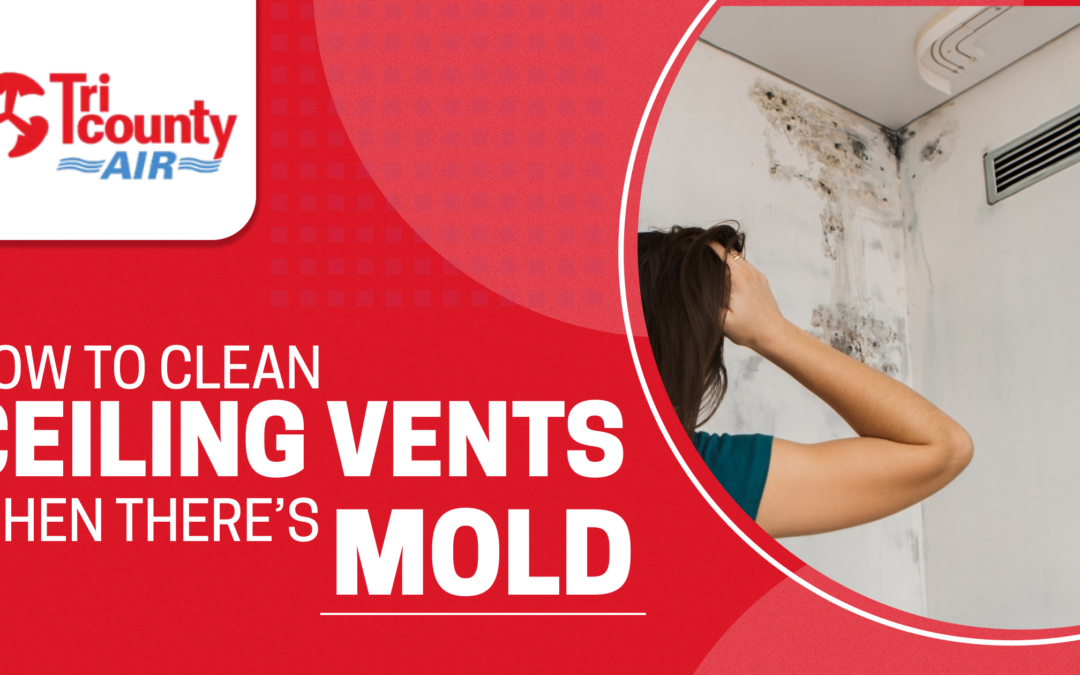The sooner you clean mold from ceiling vents, the more likely you can stop it from spreading. It’s unsettling to see mold growing anywhere. You want to act quickly. Mold near a vent can release spores (and sometimes toxins) into the airflow from your AC. It can also get in the ductwork, where it’s much harder to clean. Either scenario creates indoor air quality concerns. But we’ll explain how to clean ceiling vents to avoid further trouble.
Ways to Clean Mold on Ceiling Vents
While you cannot see mold growing in your air ducts, it’s in plain sight around a ceiling vent. Condensation provides moisture for mold to grow, and dust provides a food source for it to feed on. So, air vents are often an ideal location.
If you see black, green, brown, white, orange, or black stains or specks around a ceiling vent, turn off your HVAC unit. Proceed with cleaning if the substance appears localized. But if it appears to be growing deep inside the vent or you notice musty odors, schedule professional testing to verify if it’s mold (and identify the type).
Otherwise, your options include:
Removing and Cleaning The Vent
Unscrew or detach the vent from its fitting. Then take the grill outside and rinse it off with a garden hose. Spray the cover with a disinfectant and let it soak for 10 minutes. Rinse the vent off again. Reinstall it when it looks clean and has dried.
Use Vinegar and Water
Pour white distilled vinegar into a spray bottle, and while standing on a ladder, spray the vent cover and ceiling around it. Let the vinegar sit for an hour. Then soak a clean cloth in plain water and, being careful not to cut yourself on sharp metal, wipe the mold from the vent. If the stains are hardened, you can use a scrubbing brush with firm bristles.
Soak up the moisture by pressing or dabbing a dry, absorbent cloth against the areas you treated. Open a few windows to speed drying and dissipate the vinegar smell.
Laundry Detergent/Dish Soap
Water and detergent are also effective for cleaning ceiling vents. Remove the vent grill and submerge it in a basin filled with water. Add a few drops of detergent or dish soap. Let the vent cover soak for about 15 minutes; during this time, clean any dust or debris around the ceiling vent with a HEPA vacuum. Using soapy water, spray and wipe down the inside of the air vent, and then spray a disinfectant inside it and on the vent grill. Also, spray the area surrounding the vent.
Reattach the vent cover once the area has thoroughly dried.
Detergent and Baking Soda
Mix a cup of water, a tablespoon of laundry or dishwasher detergent, and a tablespoon of baking soda in a large basin. You can increase the amounts in the same ratio if necessary, as you’ll need enough solution to submerge the vent grill. Place the air vent cover in the solution. While you let it sit for 15 minutes, clean the inside of the air vent with a HEPA vacuum and wipe the inside with the same mixture.
Next, take the grill out of the solution, and scrub away any remaining mold or dirt. Use a clean cloth to dry the cover and the inside of the vent before you reattach it.
Bleach
Bleach is effective for cleaning non-porous surfaces when there’s mold around air vents. Wearing gloves and eye protection, mix one part bleach with 16 parts water. Follow any instructions provided on the product packaging (which may advise a different ratio). Remove the vent cover and place it in the solution. After vacuuming the vents, dip a rag into the solution and use it to scrub the air vent.
Once the inside of the vent is dry and the grill is scrubbed clean with a brush or rag and allowed to dry, you can reattach it.
When to Call for Help
The air vent may not stay clean for long if there’s additional mold. You can replace the vent grill with a new one. But if the mold keeps growing back and you notice persistent musty odors, and/or have coughing, wheezing, shortness of breath, and other symptoms, call a professional to inspect your ductwork and use a more effective cleaning method. Mold will continue growing in damp, dark areas if not treated and can damage air ducts and HVAC equipment.
Call Tri County Air
We employ a range of solutions to address mold and improve indoor air quality. A UV light air purifier can reduce mold spores, odors, and even bacteria and viruses when it’s installed in your HVAC system. For help from a professional who knows how to clean ceiling vents and air ducts, request your appointment online or call (941) 485-2222.

